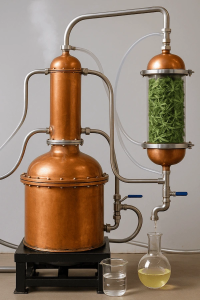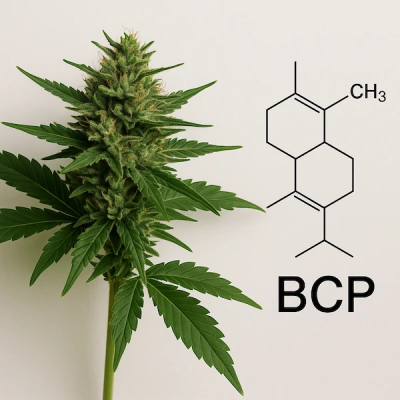Steam distillation of hemp - its products and benefits
Author: Lucie Garabasova
What makes hemp hemp? It’s not just CBD or THC – it’s all about the smell and taste. Terpenes, aromatic compounds that can be obtained through gentle steam distillation, are the key to the distinctive aroma. And while cannabinoids face complex regulation, hemp terpenes are a legal raw material for breweries, beverage manufacturers, cosmetics and food. Discover how the centuries-old technique of steam distillation opens the door to modern uses for this fascinating plant.
What is steam distillation of hemp?
Steam distillation is a physical process in which hot steam passes through hemp and “takes away” volatile aromatic substances – mainly terpenes. These are released at 100–120 °C, i.e. at temperatures that preserve their sensitive structures.
Cooling the steam creates a mixture of essential oil (rich in terpenes) and hydrolate (water with a subtle hemp aroma). The two fractions are then separated and can be used in various products.
How does it work in practice?
A steam distillation device has four basic parts:
- A boiler with water that is heated to boiling point.
- A distillation chamber filled with cannabis flowers and leaves.
- A condenser where the steam cools and turns back into a liquid.
- A separator where the oil is separated from the water.
The entire process takes several hours and is gentle – without chemicals and without damaging the active ingredients. The yield is usually 0.1–1% of the weight of the dry plant, but the resulting oil is extremely concentrated and fragrant.
Steam distillation vs. alcohol extraction
| Method | What we get | Advantages | Disadvantages | |
|---|---|---|---|---|
| Steam distillation | Terpenes (e.g. limonene, pinene, myrcene, BCP) | Pure product without chemicals, natural aroma, suitable for food, organic | Does not extract cannabinoids, lower yield | |
| Alcohol extraction | Cannabinoids (CBD, CBG, THC) | High concentration, precise control of composition | Loss of terpenes, possible alcohol residue, cleaning required | |
Modern producers often combine these two methods – first they obtain terpenes by steam distillation and then cannabinoids by alcohol extraction. Finally, the terpenes are returned to the extract to restore the natural profile of the plant and enhance the so-called entourage effect – the mutual synergy of cannabinoids and terpenes.
💚 Why steam distill hemp
- Obtaining valuable terpenes
Terpenes represent a legal, highly valuable raw material for the food industry, cosmetics and aromatherapy. - Legal and commercial advantage
Unlike cannabinoids, terpenes are freely tradable and allow export to countries where CBD is regulated. - Sustainability
The method is ecological and allows a zero-waste approach – the distilled material can then be used for cannabinoid extraction or as biomass. - Material valorization
Leaves, stems or surpluses from production can also serve as a source of aromatic substances.
Hemp Terpenes: A Scientific Perspective
Terpenes are natural aromatic compounds that give plants their aroma, protect them, and influence the effects of cannabis. Over 150 of them have been discovered in cannabis – the best known include myrcene, limonene, pinene, linalool, humulene, and beta-caryophyllene (BCP), which also affects the endocannabinoid system.
👉 Read more about how terpenes work and why they are important in our article on terpenes.
BCP as a dietary cannabinoid
The most fascinating property of beta-caryophyllene is its ability to bind to the CB2 receptors of the endocannabinoid system. This makes it the only known dietary cannabinoid that is not technically a cannabinoid in the chemical sense.
What does this mean?
CB2 receptors are found primarily in the immune system and peripheral tissues. Unlike CB1 receptors (which are activated by THC and cause psychoactive effects), activation of CB2 receptors does not cause intoxication.
BCP acts as a selective CB2 agonist, which means that:
- It binds specifically to CB2 receptors
- It activates them without affecting CB1 receptors
- It can modulate the immune response
- Potential anti-inflammatory effects
Safety of BCP in food
Beta-caryophyllene has an excellent safety profile:
GRAS status (Generally Recognized As Safe) - Granted by the FDA (Food and Drug Administration, USA), which means that the substance is considered safe for use in food based on a long history of safe use.
EFSA approval - The European Food Safety Authority has confirmed its safety for use as a flavoring agent.
FEMA GRAS - The Flavor and Extract Manufacturers Association has classified BCP as a safe flavoring agent.
Long History - People have consumed BCP for millennia through common foods and spices, with no known adverse effects.
🎯 Try BCP products too
They promote calm, balance and natural defenses without containing CBD or THC..
View productsBCP Products: When Flavoring Brings Side Benefits
The primary reason for adding beta-caryophyllene to products is its excellent flavor profile - a spicy, peppery, woody note that adds depth and complexity to products. However, due to the unique properties of BCP, these products can offer side benefits that go beyond just flavoring.
Try BCP products for yourself:
.
What we know from the research:
In vitro studies (laboratory cells) show:
- Activation of CB2 receptors
- Reduction in the production of pro-inflammatory cytokines
- Antioxidant activity
In vivo studies (animal models) suggest:
- Possible anti-inflammatory effects
- Potential analgesic (pain-relieving) properties
- Gastroprotective effects
Clinical studies (humans) are limited, but some suggest:
- Good tolerance and safety
- Possible effect on inflammatory markers
More about the effects of BCP HERE.
Conclusion
Steam distillation of hemp represents a sophisticated, ecological and economically interesting method to exploit the full potential of this versatile plant.



